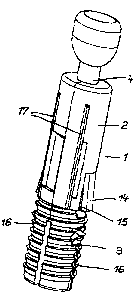Some of the information on this Web page has been provided by external sources. The Government of Canada is not responsible for the accuracy, reliability or currency of the information supplied by external sources. Users wishing to rely upon this information should consult directly with the source of the information. Content provided by external sources is not subject to official languages, privacy and accessibility requirements.
Any discrepancies in the text and image of the Claims and Abstract are due to differing posting times. Text of the Claims and Abstract are posted:
| (12) Patent Application: | (11) CA 2411511 |
|---|---|
| (54) English Title: | CONNECTOR BETWEEN TWO STRUCTURAL ELEMENTS |
| (54) French Title: | CONNECTEUR DE LIAISON DE DEUX ELEMENTS DE STRUCTURE |
| Status: | Deemed Abandoned and Beyond the Period of Reinstatement - Pending Response to Notice of Disregarded Communication |
| (51) International Patent Classification (IPC): |
|
|---|---|
| (72) Inventors : |
|
| (73) Owners : |
|
| (71) Applicants : |
|
| (74) Agent: | SMART & BIGGAR LP |
| (74) Associate agent: | |
| (45) Issued: | |
| (22) Filed Date: | 2002-11-08 |
| (41) Open to Public Inspection: | 2003-05-09 |
| Availability of licence: | N/A |
| Dedicated to the Public: | N/A |
| (25) Language of filing: | English |
| Patent Cooperation Treaty (PCT): | No |
|---|
| (30) Application Priority Data: | ||||||
|---|---|---|---|---|---|---|
|
In order to create a connector between two structural elements 10, 12, in
particular panels; which comprises a bolt 5 that is supported in a sleeve 1
that consists of an upper section 2 and a lower section 3, the lower section 3
of the sleeve together with the rear end 7 of the bolt fitting into a recess 9
in
the first structural element 10, and the upper section 2 of the sleeve
together with the front end 5 of the bolt fitting into a recess 11 in the
second
structural element, and the bolt head 6 working in conjunction with a holding
or gripping device that is arranged in the second structural element 12, and
which can be used regardless of the type of installation, there is one or a
plurality of bars 14 arranged on the part of the upper section 2 of the sleeve
that is adjacent to the lower section 3 of the sleeve, said bars extending
obliquely outward towards the lower section 3 of the sleeve and pivoting
toward the sleeve 1.
Note: Claims are shown in the official language in which they were submitted.
Note: Descriptions are shown in the official language in which they were submitted.

2024-08-01:As part of the Next Generation Patents (NGP) transition, the Canadian Patents Database (CPD) now contains a more detailed Event History, which replicates the Event Log of our new back-office solution.
Please note that "Inactive:" events refers to events no longer in use in our new back-office solution.
For a clearer understanding of the status of the application/patent presented on this page, the site Disclaimer , as well as the definitions for Patent , Event History , Maintenance Fee and Payment History should be consulted.
| Description | Date |
|---|---|
| Application Not Reinstated by Deadline | 2007-11-08 |
| Time Limit for Reversal Expired | 2007-11-08 |
| Deemed Abandoned - Failure to Respond to Maintenance Fee Notice | 2006-11-08 |
| Inactive: IPC from MCD | 2006-03-12 |
| Inactive: IPC from MCD | 2006-03-12 |
| Application Published (Open to Public Inspection) | 2003-05-09 |
| Inactive: Cover page published | 2003-05-08 |
| Inactive: First IPC assigned | 2003-01-23 |
| Letter Sent | 2003-01-20 |
| Application Received - Regular National | 2003-01-08 |
| Filing Requirements Determined Compliant | 2003-01-08 |
| Inactive: Filing certificate - No RFE (English) | 2003-01-08 |
| Abandonment Date | Reason | Reinstatement Date |
|---|---|---|
| 2006-11-08 |
The last payment was received on 2005-10-07
Note : If the full payment has not been received on or before the date indicated, a further fee may be required which may be one of the following
Please refer to the CIPO Patent Fees web page to see all current fee amounts.
| Fee Type | Anniversary Year | Due Date | Paid Date |
|---|---|---|---|
| Application fee - standard | 2002-11-08 | ||
| Registration of a document | 2002-11-28 | ||
| MF (application, 2nd anniv.) - standard | 02 | 2004-11-08 | 2004-09-16 |
| MF (application, 3rd anniv.) - standard | 03 | 2005-11-08 | 2005-10-07 |
Note: Records showing the ownership history in alphabetical order.
| Current Owners on Record |
|---|
| HAFELE GMBH & CO. |
| Past Owners on Record |
|---|
| GEORG HASLER |